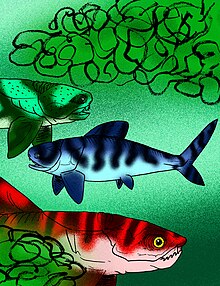Selenosteidae
| Selenosteidae Temporal range: Late Devonian,
| |
|---|---|

| |
| Driscollichthys, Amazichthys, Draconichthys | |
| Scientific classification | |
| Domain: | Eukaryota |
| Kingdom: | Animalia |
| Phylum: | Chordata |
| Class: | †Placodermi |
| Order: | †Arthrodira |
| Suborder: | †Brachythoraci |
| Clade: | †Eubrachythoraci |
| Clade: | †Pachyosteomorphi |
| Clade: | †Aspinothoracidi |
| Family: | †Selenosteidae Dean, 1901 |
| Type species | |
| Selenosteus brevis (Claypole), 1869
| |
| Genera | |
| Synonyms | |

Selenosteidae is an extinct family of small to large-sized arthrodire placoderms from the Late Devonian. With the exception of the Chinese Phymosteus, selenosteids lived in shallow seas in what is now Eastern North America (the Cleveland Shale), Eastern Europe (Holy Cross Mountains, Poland, and the Kellwasserkalk fauna of Bad Wildungen), and Northeastern Africa (the Anti-Atlas Mountains, Morocco).
Selenosteids have, in cross section, a rounded body, a blunt snout, and tremendous orbits. The lower jaws were slender, the inferognathals usually either being finely serrated, or adapted for crushing,[1] though, in Draconichthys, the inferognathals had long prongs for seizing prey.[2] The rostrum is very small.
Taxonomy
Selenosteidae is a member of the clade Aspinothoracidi, which belongs to the clade Pachyosteomorphi, one of the two major clades within Eubrachythoraci. Gorgonichthys is closely related to the family Selenosteidae, and could possibly be included in the family. The cladogram below shows the placement of Selenosteidae within Eubrachythoraci:[3]
Below is a more detailed cladogram of Selenosteidae, from Rücklin (2011):[2]
Denison (1978)[1] separated Selenosteidae into two informal groups, the "American" genera (i.e., those taxa from the Upper Famennian Cleveland Shales, such as Selenosteus and Gymnotrachelus), and the "European" genera (i.e., those taxa from the Upper Frasnian Kellwasserkalk facies of Germany, and later, Morocco, like Rhinosteus and Microsteus). Denison notes that the differences between the two groups, such as how the American genera tend to have slightly smaller orbits, and slightly longer cheeks, may suggest the similarities between them are due to parallel evolution.[1]
Rücklin (2011), on the other hand, places Pachyosteus as the most basal selenosteid, then groups the American genera (with Selenosteus grouped as the sister taxon of Gymnotrachelus and Stenosteus) as being the sister group of the remaining European/Kellwasserkalk genera, plus Draconichthys.[2]
See also
References
- ^ a b c Denison, Robert (1978). Handbook of Paleoichthyology, Volume 2, Placodermi. New York: Gustav Fischer Verlage. p. 94. ISBN 9780895740274.
- ^ a b c RÜCKLIN, MARTIN (January 14, 2011). "First selenosteid placoderms from the eastern Anti-Atlas of Morocco; osteology, phylogeny and palaeogeographical implications". Palaeontology. 56 (1): 25–62. doi:10.1111/j.1475-4983.2010.01026.x.
- ^ Zhu, You-An; Zhu, Min; Wang, Jun-Qing (1 April 2016). "Redescription of Yinostius major (Arthrodira: Heterostiidae) from the Lower Devonian of China, and the interrelationships of Brachythoraci". Zoological Journal of the Linnean Society. 176 (4): 806–834. doi:10.1111/zoj.12356. ISSN 0024-4082.







